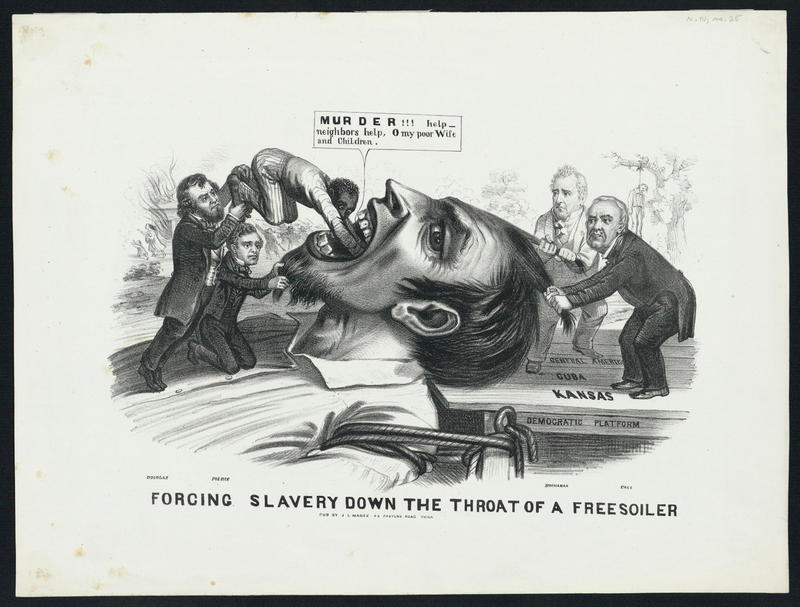"Forcing Slavery Down the Throat of a Freesoiler"
By Will McCollister
Harper’s Weekly was a periodical that published columns, cartoons, and stories, which related to current events, from the antebellum era into the early 20th century. This paper will analyze a famous cartoon published in the pre civil war years by Harper’s Weekly, and illustrated by John L. Magee. The cartoon depicts a man being tied and held down and having a slave shoved down his throat by leading Democratic politicians of the time. This paper will explain what the Freesoilers, Democrats, and slaves represent in the cartoon. To fully understand the cartoon and the metaphors John L. Magee used, one must first look at the political climate of the time and the publishing company. This paper will describe both of those aspects to explain the purpose of the cartoon, and how Magee and Harper’s Weekly were advocates for the Free Soil Party’s agenda of stopping the expansion of slavery into the territories, and how the Democrats were forcing slavery upon them.
The cartoon, “Forcing Slavery Down the Throat of a Freesoiler” was illustrated in 1856, a very turbulent time in American politics. The country had narrowly avoided Civil War through several congressional compromises. In 1854 the Kansas-Nebraska Act was passed enabling territories above the Missouri Compromise line to become slave-owning states. Stephen Douglas proposed the use of popular sovereignty, allowing the citizens to vote to decide whether these territories would be free or not, leading to the mass migrations of Freesoilers, and slave supporting southerners to Kansas. Skirmishes in the Kansas territory, which lead to 56 deaths, gave it the nickname “Bleeding Kansas” (Lee, 2015). The tension over the issue of slavery in the territory was at an all time high when this cartoon was published. The cartoon itself depicts this controversial issue of the expansion of slavery into territorial grounds in the west.
In this cartoon, John L. Magee and Harper’s Weekly took the side of the Free Soil Party. The Free Soil party, which is represented by a giant man, ran on the platform that slavery should remain in the southern states, and the expansion of the institution should not be a viable option for the territories introduced into the union (Foner, 1965). Magee’s advocacy of the freesoil position is evident by the fact that the Freesoiler is represent by a giant, while the Democrats are much smaller, representing the small-mindedness of the Democratic Party at the time. The giant is being held down by force, as he screams out “Murder!!! Help- neighbors help, O my poor wife and children,” as the Democrats look on emotionlessly, and Cass even has a wicked grin breaking across his face (Harp Week).
The Democrats, who are represented in the cartoon by Stephen Douglas, Franklin Pierce, James Buchanan, and Lewis Cass, believed in the expansion of slavery into the western territories and also into Central American and Cuba. In the cartoon, the giant is force fed a slave and is lying upon a platform that reads, “Central America, Cuba, and Kansas”(Harp Week). Harper’s Weekly and the illustrator John L. Magee were consistently critical of Democrats on this issue. In the same year Magee illustrated a cartoon of Preston Brooks viciously beating Charles Sumner, and Harper’s Weekly remained an advocate of the Northern policies throughout the war by publishing images of slave brutality, like “The Scourged Negro” and through stories that promoted the Union cause (Silkenat, 2014).
Small details in the background of the cartoon hint at the brutality of the institution of slavery with a man that has been hung by a tree branch. The slave is being physically fed to someone to die. The cartoon was being used not only to promote the Freesoil ideals, but to try and bring light on how the expansion of slavery was immoral, and how the Democrats were forcing it upon the public (Harp Week).
In conclusion, this paper has shown that the expansion of slavery into the new territories had become the most divisive issue in American politics, and John L. Magee and Harper’s Weekly had become the most forceful advocates of the freesoil position. This political cartoon was, and others like it were a powerful means by which they advocated the freesoil position, and through which they fought the expansion of slavery. The conflict represented in this cartoon, was in reality the beginning of the Civil War. Slavery had been controversial for decades, but it was in “Bleeding Kansas” that this issue erupted into large-scale violence for the first time.
Bibliography:
“American Political Prints 1766-1876.” Harp Week.com, accessedFebruary 2, 2015. http://loc.harpweek.com/LCPoliticalCartoons/DisplayCartoonLarge.asp?Ma xID=&UniqueID=9&Year=1856&YearMark=1856
Foner, Eric. 1965. "Politics And Prejudice: The Free Soil Party and the Negro, 1849-1852." Journal Of Negro History 50, no. 4: 239-256. America: History & Life, EBSCOhost (accessed February 3, 2015).
Lee, Susanna. “The End of Compromise.” Lecture, History 346 Civil War Reconstruction from North Carolina State University, Raleigh, North Carolina February 3, 2015.
Silkenat, David. 2014. "“A Typical Negro”: Gordon, Peter, Vincent Colyer, and the Story behind Slavery's Most Famous Photograph." American Nineteenth Century History 15, no. 2: 169-186. America: History & Life, EBSCOhost (accessed February 3, 2015).
